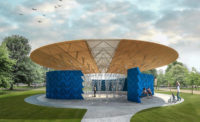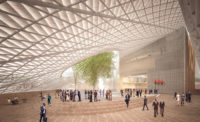Newsmaker: Diébédo Francis Kéré




















Architects & Firms

|
| Photo © David Heerde |
Diébédo Francis Kéré’s story is remarkable: He grew up in poverty-stricken Burkina Faso, won a scholarship to study carpentry in Germany, and went on to earn an architecture degree from the Berlin Technical University. While still a student, he built his first project: a school in Gando, his native village, which received a 2004 Aga Khan Award and starred in the recent MoMA exhibition Small Scale, Big Change.
Today, Kéré lives in Berlin but remains focused on designing (and raising money for) sustainable buildings in Africa. His work isn’t going unnoticed. In addition to receiving the 2009 Global Award for Sustainable Architecture, Kéré recently won the BSI Swiss Architectural Award, a $100,000 prize. Here, Architectural Record editor Jenna M. McKnight speaks with Kéré about his background, his current projects, and his aspirations for the future.
Architectural Record: What led you to become an architect?
No. There is only one architecture school in French-speaking West Africa, in Togo, and it has fewer than 200 students. They don’t have access to information, they don’t have the chance to discover and be inspired by other projects. I am very privileged.
Which architects have inspired you?
This is difficult to say. I am impressed by the quality of design by many architects. Of course there is Mies as the rationalist, whose work I studied at university. But if there is one architect I admire the most, it is Louis Kahn. His dedication to architecture is so unique and inspiring to me.
Architecture school can be very competitive. Was it difficult studying in Germany?
I tried not to be the best, but to have a good project. Everyone said, You don’t want to build a skyscraper? You don’t want to build a huge villa? I said, No, nobody needs it in Gando. My greatest concern was to learn how to use very simple techniques to do something for my community, and to be able to teach people these techniques. I started to look at brick production, to study how people built in Europe’s past, and from there I discovered the longest-lasting things are not high-tech but are made by people with local means.
Your first project, the Gando primary school, is made of clay bricks. Considering you studied architecture in Europe, were villagers surprised that you wanted to use a traditional material instead of, say, concrete?
They were thinking the Germans had brainwashed me.
Once you started building it, and engaging them in the process, I imagine they became receptive. Do they like the school?
They are really proud; they really love it. We built the first school for 120 pupils, and three years later, we had to make an extension because there was a big demand. Now we have 800 students; we’re going to have 1,000 next year. For you, here in the U.S., it may seem like it’s nothing. But for my village in Burkina Faso, it is significant.
You must feel satisfied.
More than that. I am proud of my people, that we have done this together.
Are you working on other projects in Gando?
I am building a library, which is under construction. I look forward to being able to build a high school. The government has agreed to send the teachers, so I don’t have to worry about that; I just need to construct the building. And then, I am looking forward to building a women’s center. It would empower women and help them become more economically independent, because women suffer the most in developing countries. It is going to be my most important project.
Do you have funding?
I am still waiting for complete sponsorship. I want somebody who really understands what we are doing. I am really connected to this project. I need 100,000 euros. It’s not a lot of money when you regard what it can be.
You now have commissions outside of your homeland — a park in China, for instance, and a permanent exhibit for the International Red Cross and Red Crescent Museum in Switzerland. Why are you expanding the scope of your work?
I have to lead a life, and I need this money to keep developing ideas for my people. When you earn the money yourself, you can use it how you like.
Do you think it’s good when Western architects come work in Africa?
Yes, when it’s a convergence, an exchange. When you have somebody from the U.S., which has modern knowledge, and someone from my culture, which is traditionally strong — when they work together in a real partnership, it is great.
Do you think there’s a growing interest in humanitarian design?
Oh yes. Climate change, the economic crisis, the need for infrastructure — students are seeing there are opportunities to make a difference. And some well-known architects are starting to talk about going back to the root. Everything is interconnected; we are all living in the same world. And you can change your world, step by step.












